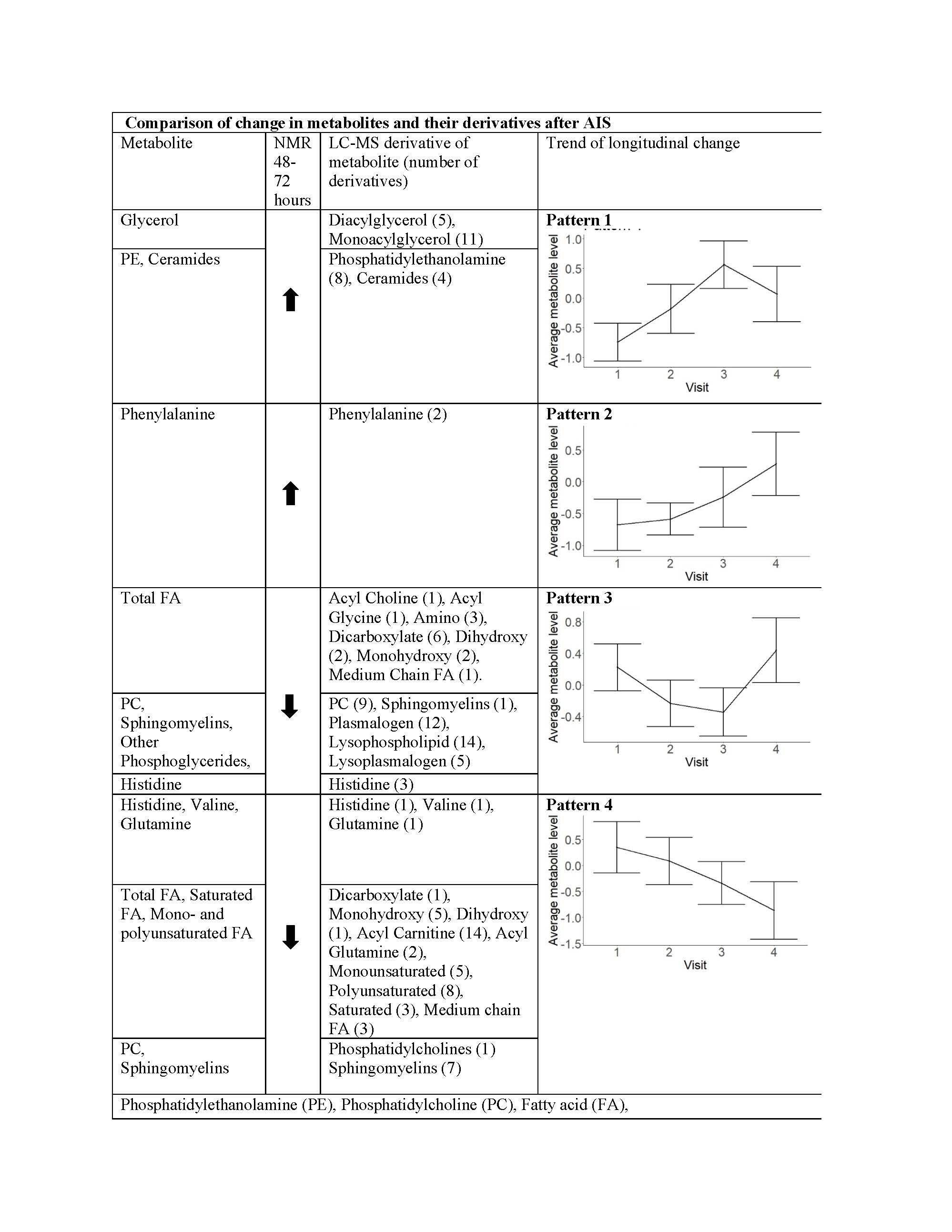Final ID: WP387
Corraborated Evidence on Change of Metabolome after Ischemic Stroke due to Large Vessel Occlusion
Abstract Body: Background: Metabolomics is commonly used to search for acute ischemic stroke (AIS) biomarkers. However, many studies which found metabolite - AIS associations have contradictory findings, which prevents solid conclusion. To obtain corroborative evidence on change of serum metabolome after AIS, our study: (1) focused on patients with large vessel occlusion (LVO), (2) combined cross-sectional and longitudinal study designs, and (3) performed analysis using different metabolome platforms: Nuclear Magnetic Resonance (NMR) and Liquid Chromatography-Mass Spectrometry (LC-MS).
Methods: In the cross-sectional part of the study, we compared serum metabolome of 84 LVO stroke patients and 82 controls using NMR (250 compounds), with multivariate regression. Samples were collected 48-72 hours after AIS. In the longitudinal part we prospectively analyzed serum metabolome using LC-MS (1554 compounds) on 15 LVO stroke patients at 4 time-points: <24 hours, 48-72 hours, 5-7 days, 80-120 days using mixed regression model. Our hypothesis is that serum metabolites elevated in cross-sectional part would show rising trajectory in longitudinal part, and vice versa. We used age, gender, race as covariates, and the Two-Stage Benjamini & Hochberg procedure for multiple testing.
Results: All patients and controls had equal characteristics. 18 significant metabolites from the cross-sectional part had 152 corresponding derivatives with significant change in the longitudinal part, which showed 4 patterns of metabolome change after AIS (Table 2). Glycerol, phosphatidylethanolamine (PE), ceramide, phenylalanine were significantly increased in the cross-sectional part, while their derivatives had well-ordered rising trajectory in the longitudinal part during first week, then either continued to increase or decreased. Histidine, tyrosine, valine, glutamine, phosphatidylcholine (PC), sphingomyelin, fatty acids (FA), including monounsaturated, polyunsaturated, and saturated fatty acids were decreased in the cross-sectional part, while their derivatives had well-ordered declining trajectory on the longitudinal part during first week, then either continued to decrease or increased.
Conclusion: We obtained corroborated evidence that glycerol, PE, ceramide and phenylalanine are increasing, while histidine, tyrosine, valine, glutamine, PC, sphingomyelin, and FA are decreasing after LVO strokes. Future studies should evaluate the clinical impact of these findings.
Methods: In the cross-sectional part of the study, we compared serum metabolome of 84 LVO stroke patients and 82 controls using NMR (250 compounds), with multivariate regression. Samples were collected 48-72 hours after AIS. In the longitudinal part we prospectively analyzed serum metabolome using LC-MS (1554 compounds) on 15 LVO stroke patients at 4 time-points: <24 hours, 48-72 hours, 5-7 days, 80-120 days using mixed regression model. Our hypothesis is that serum metabolites elevated in cross-sectional part would show rising trajectory in longitudinal part, and vice versa. We used age, gender, race as covariates, and the Two-Stage Benjamini & Hochberg procedure for multiple testing.
Results: All patients and controls had equal characteristics. 18 significant metabolites from the cross-sectional part had 152 corresponding derivatives with significant change in the longitudinal part, which showed 4 patterns of metabolome change after AIS (Table 2). Glycerol, phosphatidylethanolamine (PE), ceramide, phenylalanine were significantly increased in the cross-sectional part, while their derivatives had well-ordered rising trajectory in the longitudinal part during first week, then either continued to increase or decreased. Histidine, tyrosine, valine, glutamine, phosphatidylcholine (PC), sphingomyelin, fatty acids (FA), including monounsaturated, polyunsaturated, and saturated fatty acids were decreased in the cross-sectional part, while their derivatives had well-ordered declining trajectory on the longitudinal part during first week, then either continued to decrease or increased.
Conclusion: We obtained corroborated evidence that glycerol, PE, ceramide and phenylalanine are increasing, while histidine, tyrosine, valine, glutamine, PC, sphingomyelin, and FA are decreasing after LVO strokes. Future studies should evaluate the clinical impact of these findings.
More abstracts on this topic:
A First-in-Class EV-miRNA Diagnostic System for Early Identification of IVIG-Resistant Kawasaki Disease
Nakaoka Hideyuki, Hirono Keiichi, Hara Akane, Tsuboi Kaori, Ibuki Keijiro, Ozawa Sayaka, Ichida Fukiko
Anomalous Origins: Hereditary Transthyretin Cardiac Amyloidosis Mimicking Ischemia in a Patient with Congenital Coronary AnomaliesLabin Jonathan, Carmona Rubio Andres, Liu Joseph, Hanna Mazen, Menon Venu, Higgins Andrew
Readers' Comments
We encourage you to enter the discussion by posting your comments and questions below.
Presenters will be notified of your post so that they can respond as appropriate.
This discussion platform is provided to foster engagement, and simulate conversation and knowledge sharing.
You have to be authorized to post a comment. Please, Login or Signup.
Rate this abstract
(Maximum characters: 500)

